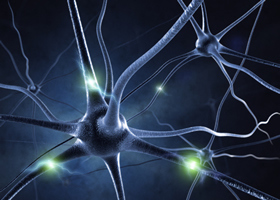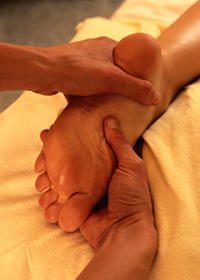Our Services
Painful Toes
Bunions and hallux limitus are the two most common causes of big toe pain. Normally, the big toe bends about 60-75 degrees when you walk. If your foot is very flat, if your toe or foot has been injured, if you are getting older, or if you wear shoes that are too tight, too much pressure may be placed on the joint, limiting its motion. Over time, the joint can become painful, stiff, deformed, and eventually destroyed.
Stiffness of the big toe joint is known as hallux limitus; "hallux" means "big toe," and "limitus" means "limited." Hallux limitus is usually accompanied by pain and arthritis in the big toe joint. It is a degenerative condition, meaning it gets worse over time. If hallux limitus is left untreated, the joint may eventually fuse, losing all motion ("hallux rigidus"). Early detection and treatment is key to limiting damage.
Many people with hallux limitus develop a deformity known as a bunion. A bunion occurs when pressure on the big toe gradually forces it to bend toward or under the second toe, and a bump forms on top of the joint.
Peripheral Neuropathy

Peripheral neuropathy may develop because of a nerve disease or as a side effect of an illness or medication. Common causes among Americans are diabetes, chemotherapy, chronic alcoholism, multiple sclerosis, and heavy metal toxicity.
Our physicians have undergone special training to treat peripheral neuropathy using the latest surgical techniques. Some of the advanced procedures we offer are nerve decompression and partial joint denervation to relieve foot, ankle, knee and leg pain.
Heel Pain
There is a ligament along the bottom of the foot called the plantar fascia that stretches from the heel to the base of the toes. If the ligament is forced to stretch beyond its limit, it may become inflamed and result in heel pain, a condition called plantar fasciitis. Patients often complain of discomfort in the heel, the arch of the foot or the back of the leg when walking. The pain is usually worst upon getting up after sitting or lying down for an extended period of time.
Bone spurs are a common complication of plantar fasciitis. Bony calcium growths on the bottom of the heel, they form where the plantar fascia pulls on the heel bone. Spurs don't usually cause pain themselves, but they are often a good indicator of the severity and duration of the underlying problem.
Treatments for plantar fasciitis begin with rest and stretching exercises, and in some cases, anti-inflammatory medications such as ibuprofen. These should help alleviate pain within two months, and together with certain lifestyle adjustments, they reduce the risk of the condition recurring or becoming a chronic ailment. Cortisone injections, arch support and orthotic inserts may be recommended as well. Patients who continue to experience pain after these conservative methods may benefit from corticosteroid injections or surgery.
Plantar Fasciitis / Heel Bone Spurs
There is a ligament along the bottom of the foot called the plantar fascia that stretches from the heel to the base of the toes. If the ligament is forced to stretch beyond its limit, it may become inflamed and result in heel pain, a condition called plantar fasciitis. Patients often complain of discomfort in the heel, the arch of the foot or the back of the leg when walking. The pain is usually worst when getting up after sitting or lying down for an extended period of time.
Bone spurs are a common complication of plantar fasciitis. Bony calcium growths on the bottom of the heel, they form where the plantar fascia pulls on the heel bone. Spurs don't usually cause pain themselves, but they are often a good indicator of the severity and age of the underlying problem.
Treatments for plantar fasciitis begin with rest and stretching exercises, and in some cases, anti-inflammatory medications such as Ibuprofen. These should help alleviate pain within two months, and together with certain lifestyle adjustments, they reduce the risk of the condition recurring or becoming a chronic ailment. Cortisone injections, arch support and orthotic inserts may be recommended as well. Patients who continue to experience pain after these conservative methods may benefit from corticosteroid injections or surgery.
Risk factors for developing plantar fasciitis and heel spurs include overuse during exercise, standing or walking for many hours a day, having naturally tight calf muscles, wearing shoes with high heels, and having flat feet or very high arches.
Plantar Warts Removal

While plantar warts are not usually a serious condition, many patients experience pain or embarrassment regarding this condition. Plantar warts can be removed through several different noninvasive procedures, including cryotherapy (freezing), laser surgery, cantahridin, immunotherapy and medication injections. Your doctor will decide which treatment option is best for you based on your individual condition. Some plantar warts may not require any treatment at all.
Puncture Wounds
Needle aspiration is a less invasive technique to use in wounds with little skin loss, such as puncture wounds. For this method, a small 22 gauge needle is inserted. In order to obtain a sample of the fluid to be biopsied, the clinician pulls back on the plunger and then changes the angle of the needle two or three times to remove fluid from different areas of the wound.
Shin Splints
Shin splints, or medial tibial stress syndrome, are a common exercise-related condition characterized by pain along or just behind the shins. Pain occurs about two-thirds of the way down the leg below the knee, spans several inches, and tends to worsen with activity. This discomfort results from inflammation of the thin layer of tissue covering the tibia, as well as from the bone itself and two of the muscles that attach to it (the soleus muscle and flexor digitorum longus, which help you push off your foot and flex your toes).
Shin splints are common in people who begin a new training regimen after a period of inactivity. They may also occur when intensifying an existing training regimen. Contributing factors include running speed and distance, exercising on angled or very hard surfaces, and footwear with weak support or worn soles. Runners, aerobic dancers and military personnel are prone to shin splints because of the stresses placed on their lower legs, as are people with flat feet, rigid arches and "knock knees" or "bow legs."
